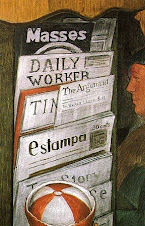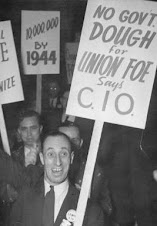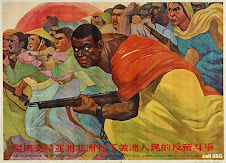by Fred Goldstein
The passage of the union-busting “right-to-work” law in Michigan is a
severe legal setback for the labor movement and for the workers, the
oppressed and all the progressive masses in the state. If not turned
around, it will encourage right-wing, anti-labor forces across the
country.
However, it must be emphasized at the outset that so far this is
purely a legislative setback. It has not been implemented. The working
class has not been defeated in the class struggle. Rather, the labor
leadership was politically outmaneuvered by a cabal of right-wing
billionaires and their political puppets in the legislature and the
governor’s mansion. These forces conspired to put this reactionary
legislation on the fast track without even giving the legally required
time and processes for the masses to mobilize against it.
The worst thing the labor movement can do now is accept this
reactionary legislation as a fait accompli and look to the electoral
arena in 2014 — a distant attempt to regain ground lost in the
legislature.
There’s a lesson to be learned from the earlier failure of the
Wisconsin so-called recall movement. In this period, as the billionaire
Koch brothers and their like pour massive funds into the electoral arena
and into advertising and propaganda, the labor movement is at a
distinct disadvantage fighting on electoral territory alone. To be on
much more solid ground, the movement must rely on its real strength —
the mobilization of the workers, the communities, the students and all
the oppressed in the class struggle.
To delay the struggle until the 2014 elections and fail to mobilize
the workers for struggle now would allow this legislation to be
enforced, so that a legislative sleight of hand is turned into a real
and profound setback for the workers. Such a delay would result in a
totally demoralizing, one-sided class struggle, in which right-wing
billionaires are allowed to bust unions.
From Wisconsin to Lansing, struggle & fightback
The unions should take their cue from the fact that between 15,000
and 20,000 workers and their allies from around the state and other
parts of the country turned out in Lansing on short notice to try to
stop the legislation. They were in a militant, fighting mood, even
though they were confronted by an emergency situation in which the
approval of the legislation was virtually assured.
The unions should also bear in mind the heroic phase of the Wisconsin
struggle when workers, students and community activists occupied the
Capitol, while tens of thousands of workers and activists from all over
the country poured into Madison. For two weeks they tried to stop the
attempt to outlaw collective bargaining among public sector workers.
Support for the Wisconsin struggle came from all over the world,
including Europe and as far away as Egypt.
At that time, the question of a general strike was posed for the
first time in decades by the labor movement — although it was quickly
abandoned.
That struggle was never allowed to reach its potential because it was
diverted into a “recall” struggle, which was really a gubernatorial
election by another name. And the bosses — who had been on the run while
the occupation and the mass demonstrations continued to grow — were
back in charge in the electoral arena with their millions in campaign
funds to bolster Gov. Scott Walker.
It is still a question whether, if Walker had been defeated in the
recall by the Democratic Party candidate, Milwaukee Mayor Tom Barnett,
the law would have been overturned.
The Michigan law, dubbed “right-to-work-for-less” by the unions, is
potentially an even-more-sweeping challenge to workers’ rights than the
Wisconsin law. To bank on an electoral challenge in 2014, or a recall,
or winning a legal challenge in the courts is folly and dangerous.
Lansing should be beginning, not end
In both Wisconsin and Michigan, the workers have shown their
willingness to rise to the occasion if given the chance and the
resources. It is more fruitful to look upon the Lansing mobilization as a
beginning of the mass struggle, not the end.
Admittedly, it will be a long and strenuous road to build the kind of
struggle required to overturn the Michigan law. But the basis for such a
mobilization exists. The right-to-work law is not the only reactionary
legislation being rammed through.
The Republican-controlled Michigan legislature passed dozens of bills
in its final sessions, including a bill revising the vicious “emergency
manager” bill that had been defeated at the polls in November.
The revised bill, like the previous one, still gives the governor the
right to appoint what amounts to a municipal dictator, called a
manager, with the power to override city laws and elected officials and
tear up union contracts, among other powers.
A law placing restrictions on physicians performing abortions,
including requiring special licensing and onerous state inspections, was
passed. A voter suppression law aimed at immigrant workers was also
passed, requiring that voters affirm their citizenship, their address,
their birth date and present a photo identification before receiving a
ballot. In addition, the state legislature passed a law eliminating $600
million in property taxes that further undermines funds for municipal
services.
Thus the legislature has attacked women, undocumented workers and
poor cities that are a majority Black, as well as unions. This is the
material and political basis for convening a broad coalition of forces
to launch a mass fightback against all these reactionary laws — laws
that affect millions.
Need to overcome defeat of Prop 2
The workers and the union leaders in Michigan, especially the United
Auto Workers leadership under Bob King, have to overcome the
demoralizing effects of a major defeat that set the stage for passage of
the right-to-work law — namely, the defeat in the November elections of
Proposition 2, which had called for inserting the right to collective
bargaining in the Michigan constitution.
This proposition lost by 14 points, 57 percent to 43 percent, even
though President Barack Obama swept the state. This came as a shock to
the labor movement. The defeat of Prop 2 during Republican Gov. Rick
Snyder’s term in office was a signal to the right wing to move the
union-busting legislation. It was passed five weeks later.
It was not just the defeat, but the large margin of the setback that
took the breath out of the labor movement. It emboldened the right to go
further and move union-busting legislation in a state known as a center
of union strength, the stronghold of the UAW. The moment the results
were announced, the leaders knew that the unions were in great danger.
They were reduced to hoping that Snyder would veto it. They went into
meetings with him, having been taken in by his earlier statements that
right-to-work was not on “his agenda.”
Snyder is a multimillionaire corporate executive, a venture
capitalist, There is no reason in the world for working-class
representatives to trust him as far as they can throw him. It was the
height of folly to give credence to his early denials. To claim now that
he stabbed the labor movement in the back is like denouncing the fox
for eating the chickens.
The unions got into this position by severely underestimating the
political influence and strength of the right wing and heavily
overestimating their own social strength. Furthermore, they adopted the
wrong strategy and tactic in dealing with an impending move to put over
the right-to-work law, which had begun in early 2011.
The Michigan Freedom to Work coalition was formed after the
Republican electoral sweep in 2010. In March 2011 Snyder sent up
“emergency manager” legislation that authorized tearing up union
contracts. Around the same time he put forward laws to prevent the
collection of teachers’ union dues.
As word spread that a right-to-work movement was afoot, the unions
realized they were facing a potential battle that could end up in a
crisis. A broad coalition of unions, headed by the UAW, launched a
campaign to preempt the right wing with the “Protect Our Jobs” amendment
— Proposition 2.
Right-wing billionaires pounced. Richard DeVos of the Amway fortune,
the 67th richest man in the U.S. with $5.1 billion, formed Protecting
Michigan Taxpayers, which poured $22.7 million into defeating
Proposition 2. (Reuters, Dec. 13) The Americans for Prosperity funded by
the Koch brothers and the American Legislative Exchange Council, a
front for right-wing corporate forces, joined the struggle. This should
have come as a surprise to nobody, given the right-wing political
climate. The defeat at the polls in Wisconsin should have rung alarm
bells against relying on electoral methods to fight back.
Also shocking was that the defeat of Prop 2 revealed the weakness of
the labor movement’s political appeal in the state. That should serve as
a wakeup call to the labor movement that it has to repair its
relationships, not only with the workers but also with the broad masses.
Build labor-community relations through popular assemblies
It is clear that many people were susceptible to the massive
anti-union propaganda spewed by the right wing. The labor movement must
take this deadly seriously. After decades of retreat before the bosses,
including the UAW’s collaboration in the elimination of hundreds of
thousands of jobs and in agreeing to a concession-riddled contract
during the auto bailout, cynicism and apathy about unions seem rife
among sectors of the workers, as well as the unorganized masses.
The widespread abandonment of the Black masses of Michigan,
especially by the UAW, in matters of jobs, foreclosures, destruction of
public education, etc., has resulted in a growing isolation of the labor
movement from the community. The same holds true among women, the LGBTQ
communities and immigrants, who have all been regarded as peripheral by
sectors of the labor movement and who at best have received lip service
from the bureaucracy.
In addition, the retreat of the labor movement, combined with the economic crisis, has devastated the unions numerically.
It was thoughtless and irresponsible for union leaders not to have
taken all these factors into consideration before launching the
constitutional amendment project. For them not to have considered what
would happen if they lost, thereby revealing their weaknesses and
vulnerability to the class enemy, was to recklessly court danger.
Wisconsin showed that, when faced with the potential of a legislative
initiative attacking the unions, the correct course was to begin the
long and difficult process of mobilizing the union rank and file and
then forging alliances with the oppressed communities.
At the time of the legislative crisis, when the workers massed in
Lansing on Dec. 11 to protest the law, the Committee to Beat Back RTW
promoted a call for the movement to consider a general strike and to
form popular assemblies of women, the LGBTQ communities, the immigrant
community, students and youth, and all the popular organizations to
unite to carry out a mass strike.
Many of the workers at the Lansing demonstration responded with
enthusiasm to this appeal. A strategy along these lines is the only road
back from this defeat. The longest journey begins with a single step.
The Lansing demonstration should be regarded as that single step, to be
followed by many more on the road to defeat union busting, exploitation
and oppression of all types.
Subscribe to:
Post Comments (Atom)










































No comments:
Post a Comment